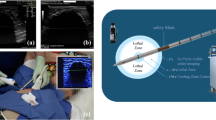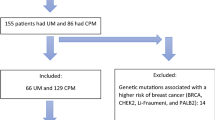Abstract
Background
Cryoablation has been established as a minimally invasive alternative to resection of early-stage breast cancer; however, there are no data on the cost and impact on patients’ financial, psychosocial, sexual, physical, and cosmetic outcomes utilizing this approach. This study compares cost-effectiveness and patient-reported quality-of-life factors in cryoablation versus resection.
Methods
Women with early-stage, low-risk infiltrating ductal carcinomas ≤ 1.5 cm underwent cryoablation or resection. Adjuvant therapy was provided according to tumor board recommendations. Direct and indirect costs were tracked for both groups. Financial toxicity and well-being outcome were measured by administering the Comprehensive Score of Financial Toxicity (COST) and BREAST-Q surveys, respectively, at 6-month follow-up.
Results
Of the 34 eligible patients, 14 (41.1%) consented for cryoablation and 20 (58.8%) underwent resection. The median (centile) (range) follow-up was 35.0 (21.3) (15-50) months for cryoablation vs. 25 (20.8) (17-50) months for resection [p = 0.6479]. Mean (standard deviation) cost of care for cryoablation versus resection was $2221.70 (615.70) versus $16,896.50 (1332.40) [p < 0.0001], and median financial well-being scores for the cryoablation versus resection groups were 38.0 (34.5, 40.0) versus 10 (5.3, 14.0) [p < 0.0001]. Poor financial well-being was directly correlated with the cost of care [p < 0.0001]. Median psychosocial well-being scores were similar across both groups, however the cryoablation group had higher scores for physical [100 (100, 100) vs. 89 (79, 100); p = 0.0141], sexual [100 (91, 100) vs. 91 (87.5, 91); p = 0.0079], and cosmetic [100 (100, 100) vs. 88 (88, 100); p = 0.0171] outcomes.
Conclusion
Cryoablation offers a cost-effective and quality-of-life advantage compared with resection for early-stage, low-risk breast cancer.


Similar content being viewed by others
References
National Comprehensive Cancer Network. Breast cancer (version 2.2022). 2022. https://www.nccn.org/professionals/physician_gls/pdf/breast.pdf. Accessed 22 Mar 2022.
Curigliano G, et al. De-escalating and escalating treatments for early-stage breast cancer: the St. Gallen International Expert Consensus Conference on the Primary Therapy of Early Breast Cancer 2017. Ann Oncol. 2017;28(8):1700–12.
Roubidoux MA, et al. Small (< 2.0-cm) breast cancers: mammographic and US findings at US-guided cryoablation—initial experience. Radiology. 2004;233(3):857–67.
Habrawi Z, et al. Cryoablation: a promising non-operative therapy for low-risk breast cancer. Am J Surg. 2021;221(1):127–33.
Fine RE, et al. Cryoablation without excision for low-risk early-stage breast cancer: 3-year interim analysis of ipsilateral breast tumor recurrence in the ICE3 trial. Ann Surg Oncol. 2021;28(10):5525–34.
Soni A. Trends in the five most costly conditions among the U.S. Civilian institutionalized population, 2002 and 2012. In: Statistical Brief (Medical Expenditure Panel Survey (US)). Statistical Brief #470. Rockville: Agency for Healthcare Research and Quality (US); 2021.
Guy GP Jr, et al. Economic burden of cancer survivorship among adults in the United States. J Clin Oncol. 2013;31(30):3749–57.
PDQ® Adult Treatment Editorial Board. PDQ financial toxicity and cancer treatment. Bethesda: National Cancer Institute. Updated 03/04/2022. https://www.cancer.gov/about-cancer/managing-care/track-care-costs/financial-toxicity-hp-pdq. Accessed 30 Mar 2022.
de Souza JA, Wong YN. Financial distress in cancer patients. J Med Person. 2013;11(2):73–7.
Zafar SY. Financial toxicity of cancer care: it’s time to intervene. J Natl Cancer Inst. 2016;108(5):djv370.
Tucker-Seeley RD, Yabroff KR. Minimizing the “financial toxicity” associated with cancer care: advancing the research agenda. J Natl Cancer Inst. 2016;108(5):djv410.
Zafar SY, et al. Population-based assessment of cancer survivors’ financial burden and quality of life: a prospective cohort study. J Oncol Pract. 2015;11(2):145–50.
Lathan CS, et al. Association of financial strain with symptom burden and quality of life for patients with lung or colorectal cancer. J Clin Oncol. 2016;34(15):1732–40.
Neugut AI, et al. Association between prescription co-payment amount and compliance with adjuvant hormonal therapy in women with early-stage breast cancer. J Clin Oncol. 2011;29(18):2534–42.
Ramsey SD, et al. Financial insolvency as a risk factor for early mortality among patients with cancer. J Clin Oncol. 2016;34(9):980–6.
Chang A, Abbott DE. Cost-effectiveness analysis in cancer care. Cancer Treat Res. 2016;168:377–91.
Mock V. Body image in women treated for breast cancer. Nurs Res. 1993;42:153–7.
Simmons RM, et al. A phase II trial exploring the success of cryoablation therapy in the treatment of invasive breast carcinoma: results from ACOSOG (Alliance) Z1072. Ann Surg Oncol. 2016;23(8):2438–45.
de Souza JA, et al. The development of a financial toxicity patient-reported outcome in cancer: the COST measure. Cancer. 2014;120(20):3245–53.
Pusic AL, et al. Development of a new patient-reported outcome measure for breast surgery: the BREAST-Q. Plast Reconstr Surg. 2009;124(2):345–53.
Hollander M, Wolfe DA. Nonparametric statistical methods. 2nd edn. New York: Wiley; 1999.
Weisberg S. Applied linear regression. New York: Wiley; 1980.
Belsley DA, Kuh E, Welsch RE. Regression diagnostics: identifying influential data and sources of collinearity. New York: Wiley; 1980.
Kaiser WA, Pfleiderer SO, Baltzer PA. MRI-guided interventions of the breast. J Magn Reson Imaging. 2008;27(2):347–55.
Littrup PJ, et al. CT-guided percutaneous cryotherapy of renal masses. J Vasc Interv Radiol. 2007;18(3):383–92.
Permpongkosol S, et al. Thermal maps around two adjacent cryoprobes creating overlapping ablations in porcine liver, lung, and kidney. J Vasc Interv Radiol. 2007;18(2):283–7.
Vitez TS. Principles of cost analysis. J Clin Anesth. 1994;6(5):357–63.
Yabroff KR, et al. Burden of illness in cancer survivors: findings from a population-based national sample. J Natl Cancer Inst. 2004;96(17):1322–30.
Gordon LG, et al. A systematic review of financial toxicity among cancer survivors: we can’t pay the co-pay. Patient. 2017;10(3):295–309.
Gilligan AM, et al. Death or debt? National estimates of financial toxicity in persons with newly-diagnosed cancer. Am J Med. 2018;131(10):1187-1199.e5.
Boing L, et al. Factors associated with depression symptoms in women after breast cancer. Rev Saude Publica. 2019;53:30.
Spiegel D, et al. Effect of psychosocial treatment on survival of patients with metastatic breast cancer. Lancet. 1989;2(8668):888–91.
Giese-Davis J, et al. Decrease in depression symptoms is associated with longer survival in patients with metastatic breast cancer: a secondary analysis. J Clin Oncol. 2011;29(4):413–20.
Safi S, Thiessen T, Schmailzl KJ. Acceptance and resistance of new digital technologies in medicine: qualitative study. JMIR Res Protoc. 2018;7(12):e11072.
Mytton OT, et al. Introducing new technology safely. Qual Saf Health Care. 2010;19(Suppl 2):i9-14.
Acknowledgment
The authors would like to thank the women who participated in this study and the dedicated nurses and clinical staff who provided medical care to the patients and collected the data. The authors also thank the CH Foundation and ASCO Equipment Endowment for Excellence in Women’s Health for their support.
Author information
Authors and Affiliations
Corresponding author
Ethics declarations
Disclosure
Sonia Y. Khan, Annie Snitman, Zaina Habrawi, Sybil Crawford, Michael W. Melkus, and Rakhshanda Layeequr Rahman have no conflicts of interest to declare.
Additional information
Publisher's Note
Springer Nature remains neutral with regard to jurisdictional claims in published maps and institutional affiliations.
Rights and permissions
Springer Nature or its licensor holds exclusive rights to this article under a publishing agreement with the author(s) or other rightsholder(s); author self-archiving of the accepted manuscript version of this article is solely governed by the terms of such publishing agreement and applicable law.
About this article
Cite this article
Khan, S.Y., Snitman, A., Habrawi, Z. et al. The Role of Cryoablation in Breast Cancer Beyond the Oncologic Control: COST and Breast-Q Patient-Reported Outcomes. Ann Surg Oncol 30, 1029–1037 (2023). https://doi.org/10.1245/s10434-022-12570-5
Received:
Accepted:
Published:
Issue Date:
DOI: https://doi.org/10.1245/s10434-022-12570-5




